Surrey Hills has a long history of aerial operations such as spraying, fertilising, controlled burns and fire fighting. These grew as the plantation estate expanded.
An airstrip was built at Basils Road in the 1980s to improve the efficiency of aerial work on Surrey Hills and adjoining land, but by the late 1980s, fixed-wing aircraft were largely replaced by helicopters. This was driven by the arrival in north-west Tasmania of an entrepreneurial helicopter pilot from New Zealand, Darryl Taylor.
The convenience of helicopters, including their ability to operate from small landing sites compared to fixed-wing aircraft, makes them the first choice for aerial operations on Surrey Hills.
This story consists of three parts: firstly, a summary of Ian Ravenwood’s discussion with Les Baker in November 2021 that focused on the fixed-wing era but includes some of his recollections of the introduction of helicopters. Secondly, Tom Fisk, the north-west Plantation Superintendent from 1988 to 1993, provides a delightful account of his first contact with Darryl Taylor in 1989.
And finally, a summary of a conversation Ian Ravenwood had with Darryl in early 2022 on his Tasmanian beginnings and the subsequent growth of his business, Heli-Spray which later traded as Tasmanian Helicopters.
Part One – the fixed-wing era
Les commenced work with Associated Forest Holdings (AFH) in 1980 as a plantation forester, and in 1982 he took over as Plantation Superintendent following Dick de Boer’s retirement. There were no routine aerial operations when he first arrived. Dick considered they led to the waste of too much money on chemicals and aircraft costs, so the way weeds were managed post-planting was primitive. In an almost third-world way, seedlings were released (or “liberated”, as Dick de Boer called it) from weeds that had grown after planting using men with a fern hook. The other way weeds were managed was with employees carrying a backpack of herbicide connected to a drench gun designed for drenching sheep. The big “innovation” with this method was the addition of a cone shield around the nozzle. It allowed a one-metre diameter circle of herbicide to be sprayed over the seedling. Although it controlled weeds in that small area, it was not enough. The squeezing of the drench gun all day was also very hard on employees. They would end up with a powerful hand grip.
To make the operation more efficient, Les introduced tractor strip spraying. It was very effective on ex-pasture blocks, but it knocked equipment around on ex-forest sites, causing breakages and downtime.
Although Dick de Boer was not keen on using aircraft for cost reasons, he allowed Les to introduce aerial spraying. The first contractor was Bender’s Spreading Services, run by Ray Bender, a very entrepreneurial Tasmanian. He started spreading fertilisers manufactured at the EZ Fertiliser plant in Derwent Park, Hobart. He subsequently created Impact Fertilisers which was very successful in Tasmania and nationally. Ray also established the salmon farm, Huon Aquaculture.
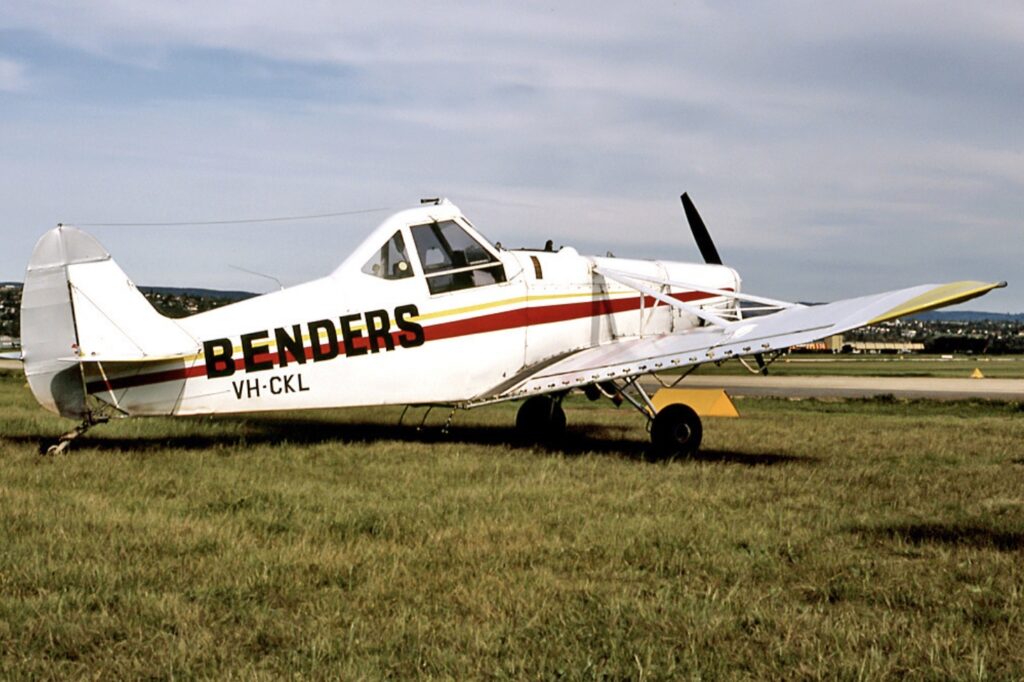
The fixed-wing aircraft needed airstrips, and closeness to the operational area was important for efficiency. For work on Surrey Hills, AFH used airstrips at Waratah and Highclere. It was relatively simple to prepare an airstrip, and Les recalls one of AFH’s tractor operators, Peter Burgess, blading off the grass to make the Highclere strip. Then, in the late 1980s, a substantial gravelled strip was built south of Hampshire at Basils Road. Les recalls being in the first plane to land on the Basils Road airstrip. It was a Victa Airtourer owned by Burnie doctor Doug Dow.
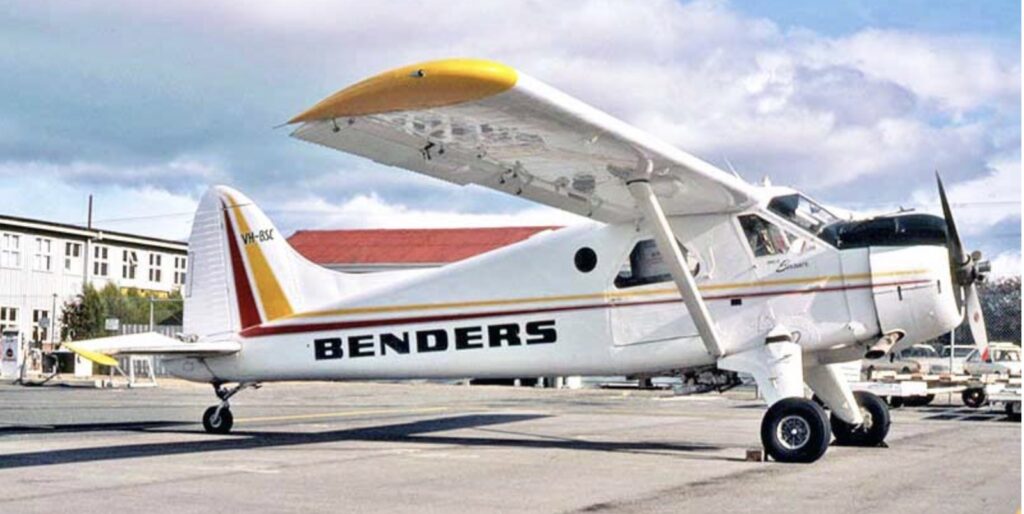
Benders flew Australian made Transavia PL-12 Airtruks, Cessna 188 Agwagons, DHC-2 Beavers and Piper PA-25 Pawnees. One of their more experienced pilots, Richard Embury, who had more than 20,000 plus flying hours, told Les that the reason for his longevity flying was “having his mind 100 per cent on the job at all times”. If external issues were distracting him, he took a break or went home for the day. Still good advice, one would imagine, for any pilot providing agricultural and forestry spreading services and working so close to the ground!
Spraying technology improved during the fixed-wing era on Surrey Hills. Hydraulic nozzles were replaced with Micronair nozzles that improved droplet size and variation, and better distribution patterns. In addition, employees deployed helium-filled balloons to mark every fifth swath to enable pilots to minimise both overlap and missed areas. Les recalls then AFH manager, Ross Hills, phoning him to demand an explanation for purchase orders he was authorising for bottled helium gas.
A prior AFH manager, Ted Crisp, was big on operational burning, and fixed-wing aircraft were then used for hazard reduction and regeneration burns on Surrey Hills and adjacent areas such as Blythe Road and the Companion area. Lighting was done with ping-pong balls filled with Condy’s crystals (potassium permanganate) and injected with glycerine (glycerol) just before being mechanically fired from the plane. It took a minute or so before the mixture would spontaneously ignite. AFH forester Brian Roberts received bombardier training from Forestry Tasmania (FT), and Les recalls him practising in the office! There were occasional misfires during operational fire lighting, and Brian would quickly retrieve them from the firer and throw them out the aircraft’s window. Imagine what a modern job risk assessment would throw up these days!
Fixed-wing aircraft were not just used for fire lighting. During the fire season, spotter flights, in conjunction with fire towers, were used for the early detection of wildfires. Quick detection meant fighting fires early before they had a chance to get big and expensive to put out. The cost of spotter flights was shared between AFH and FT. In conjunction with FT, Les introduced spray aircraft being placed on standby at the peak of the fire season to assist with putting fires out early. It was a very effective system.
Though not related to AFH’s Surrey Hills aerial operations, Les recalls the fatal crash in 1983 of a Beechcraft Baron (Beech 58) when it flew into the ground at the top of Daisy Nolan Hill near Emuvale. The aircraft was known to be missing, but searchers were unsure of its flight path. The experienced bush pilot, John Lindridge, was the only person on board. Les had flown with John the week before. In around 2010, when this plantation area was being prepared for another replant, fragments of this aircraft were rediscovered.
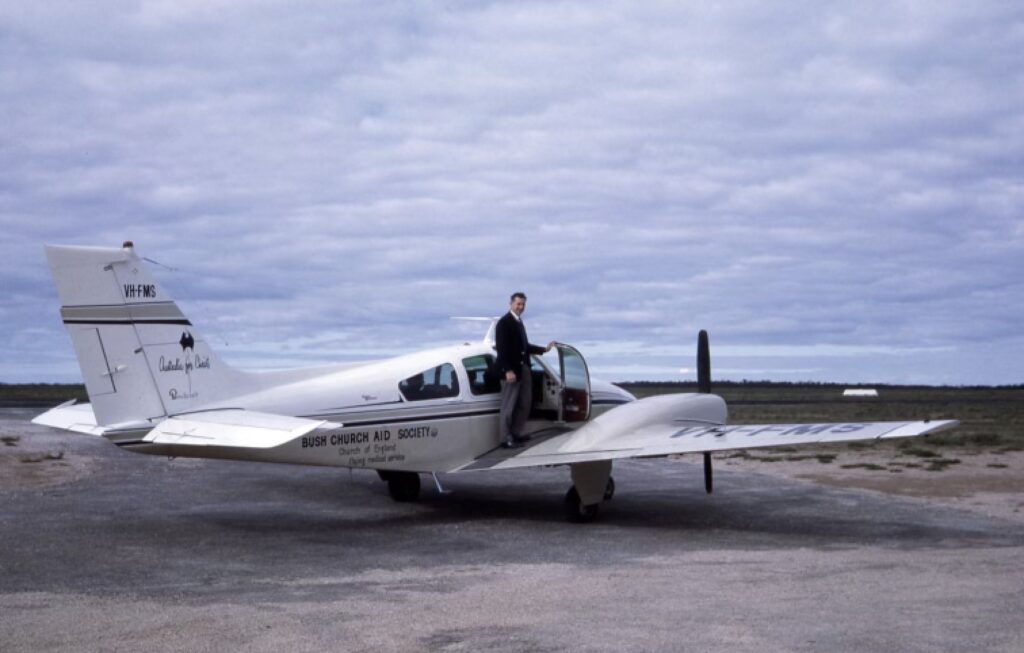
John Lindridge had previously done chartered flights for AFH. Les had a private pilot’s licence and was always looking for flying opportunities. AFH Operations Manager, Duncan Grant, was also keen to go flying with him. One day Les invited Duncan to go flying with him so he could see various operations. Duncan, however, was not enamoured with the idea of going up in the small single-engine aircraft that Les flew and declared he had to fly in a safer, twin-engined plane!
So John Lindridge came up in his Britten-Norman Islander, and Les missed out on an opportunity to add to his flying hours. Duncan Grant, Bryan Hayes from the company’s Tamar operation, and Ross Hills joined Les, who sat upfront so he could tell the pilot where to go and pointed out things on the ground to those in the back. This necessitated several steep banking turns, and Les described him and Duncan having the time of their life. Duncan continually asked, “what’s this over there” and the aircraft would turn repeatedly. However, Ross was not so happy with this continual banking one way or the other. His face slowly turned as white as a sheet, and severe motion sickness set in. Nevertheless, Duncan insisted on continuing the flight.
But it got worse, the pilot’s door broke open and swung out, with the handle falling off. The plane also became a little bit sideways with the door partly open. John Lindridge grasped the door in both hands and tried unsuccessfully to pull it in against the force of the air. Duncan Grant then leaned over John’s shoulder from the back and helped him close the door, with Ross still vomiting. Les said he had never seen such chaos in a plane.
Les recalled another amusing incident when he was a passenger in a fast Piper aircraft belonging to one of the contractors, John Rowell. He had a section of road widened to form a bush airstrip at AFH’s Woolnorth property, and he and John were travelling to it. The two AFH employees who looked after the Woolnorth property, Ernie Williams and George Gardner, were waiting outside their Landcruiser at the end of the runway – not a good place to be. Typical of such a runway, there was no windsock, and Les is sure John Rowell had no idea what the wind direction was. The Piper showed very little sign of wanting to pull up on the landing. John was on with the brakes, skidding the wheels, and getting sideways and still very little speed was shed. George and Ernie were waving hello in line with a spinning propeller. Les was sure it wouldn’t end well, but fortunately, the Piper stopped within metres of the two.
Part Two – helicopters arrive
Tom Fisk lived at West Pine, near Penguin, in a big old farmhouse surrounded by highly productive agricultural land. His block was only 1.5 acres, so it wasn’t particularly well buffered from the surrounding farming activities, mainly aerial crop spraying. Choosing to live in an intensively cropped location, he was prepared to accept there would be some negatives. However, one activity pushed the boundaries of acceptability a bit too far. His house was regularly overflown, at very low altitude, by incredibly noisy, fixed-wing Airtruks, at times depositing over-spray on his roof with the plane’s noise terrorising his young children if they were playing outside. Tom had very frequent conversations with his next-door neighbour, and the contractor involved because he knew about spraying.
Tom’s job with the company (among other things) involved overseeing the aerial spraying program, primarily for weed control and protection against predating insects. He used the same aerial spraying contractors that were doing the work around his house. Still, the stringent protocols about managing the spraying operations in the bush (often in remote locations), especially neighbour notifications, bore no relationship to what Tom experienced at home, where there were absolutely none.
Tom was surprised when one night he received a phone call from Darryl Taylor, a helicopter spraying contractor, to advise him that he’d been contracted to spray some crops around his place when conditions were suitable. Darryl wanted to discuss any concerns that Tom might have. Tom’s first words to him were, “just a minute, Darryl, while I pick myself up off the floor!” They had a productive conversation about AFH’s experiences before that time and the bizarre differences between what Tom experienced at home and how he managed the spraying program at work. Tom says Darryl’s crop spraying program around him was done professionally and caused him no concerns. He subsequently suggested to Darryl that he should come to the company’s Ridgley office to talk about using helicopters in AFH’s extensive operations. The rest is history!
There is another amusing anecdote related to the introduction of helicopters into the company’s program. One of the fixed-wing contractors heard that “the forestry” was replacing them with a helicopter contractor. He complained to the local FT manager (who he thought Tom worked for) that Tom was getting his farm sprayed at West Pine “on the cheap” by awarding a contract to Darryl Taylor. The complaint was forwarded to AFH manager Ross Hills, who discussed the matter with Tom. There was very little aerial spraying required on Tom’s 1.5-acre block with a very large house!
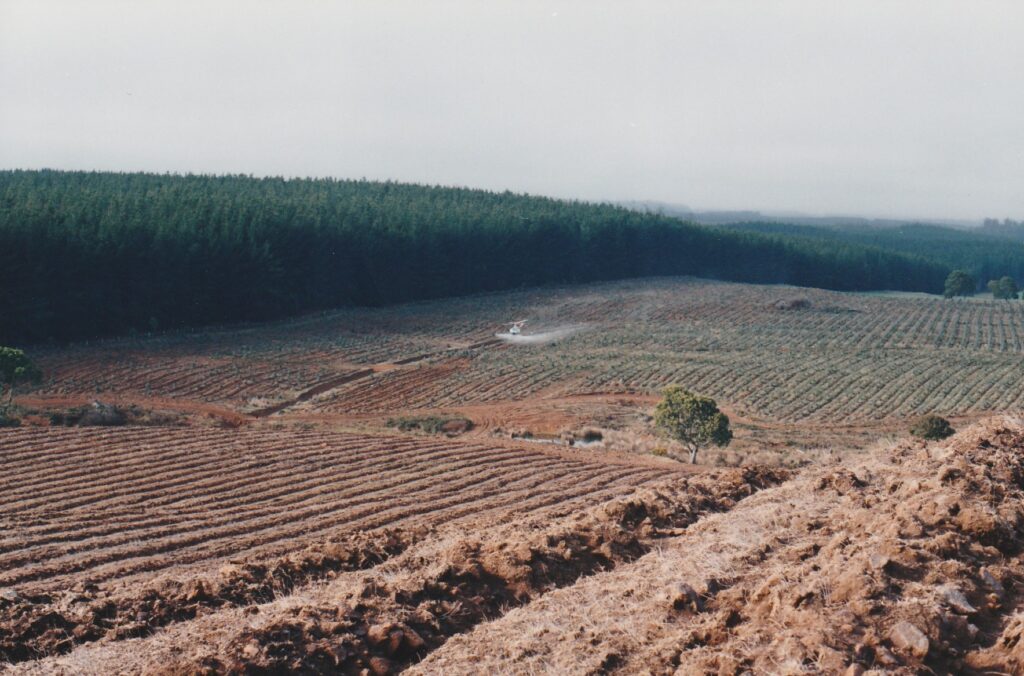
At the time, Daryl needed to get a special permit to extend his work into the forests. The fixed-wing contractors opposed granting the permit, and a Department of Transport tribunal was held to review the matter. Tom was asked to attend, which he did in support of the application. Try as they might, the fixed-wing contractors were unable to mount a case against the obvious benefits inherent in using a helicopter for large, weather dependent spraying operations in forested areas. Subsequently, helicopters became an integral part of many aspects of a rapidly growing forestry operation. All this started with a simple, unexpected phone call.
Part three – Darryl Taylor and Tasmanian Helicopters
Darryl Taylor came to Tasmania in 1987 as a contract pilot for East Coast Helicopters from the Northern Territory where he did heli-mustering stock work. He provided agricultural application services to farmers using a Hiller 12ET, mainly on potatoes, peas and grains. The Hiller was relatively small in its external lift capacity compared to today’s modern aircraft. With ground support provided from a Datsun ute, fuel was carted in 44-gallon drums, and chemical mixing was done in two drums welded together.
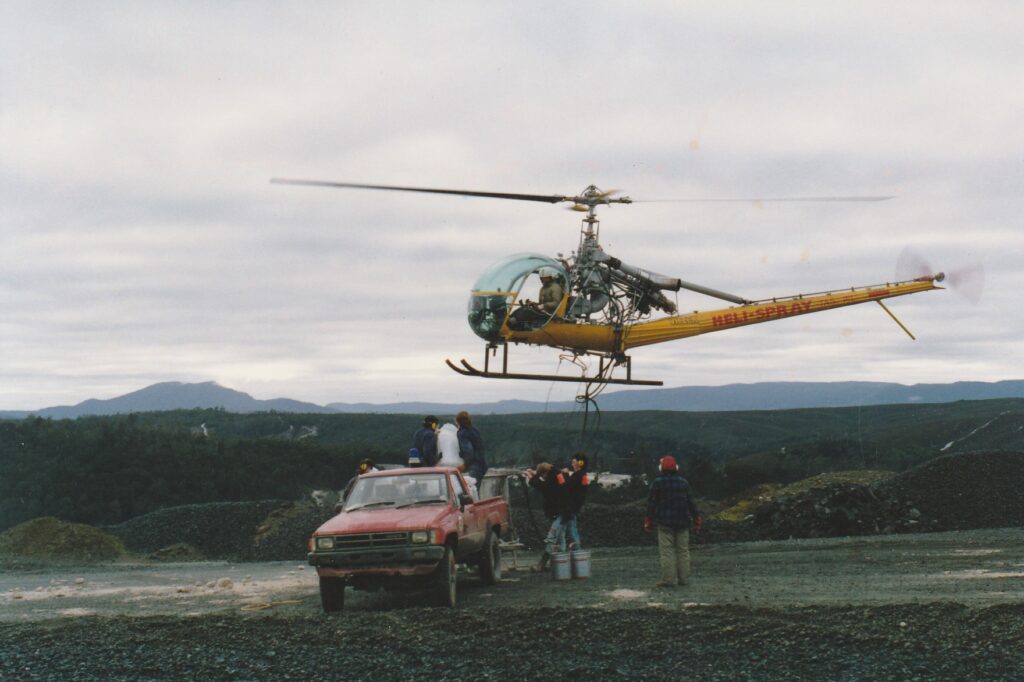
Based in Caloundra Queensland, East Coast Helicopters found operating in Tasmania difficult, and in March 1989, Darryl purchased the Hiller from them and committed to the hire of another. The Heli-Spray Company came into existence in March 1989, based at Latrobe in north-west Tasmania. Like many new businesses, that first year was tough as he contended with finding work for the aircraft and dealing with bad weather.
That initial herbicide application was followed by a significant area of defoliating insect spraying through the summer. Winter 1990 saw the herbicide spraying increase to around 3,000 hectares. The droplet and flow metering technology he used had caught the attention of other forestry companies, and work beyond Surrey Hills followed.
In 1993, a more powerful Bell Jet Ranger was purchased, and the old barn at Emuvale near Hampshire became a convenient base for Heli-Spray’s Surrey Hills operations. By 1995, Darryl had four helicopters crop spraying and two venturing into forestry work. He also started Tasmanian Helicopters P/L in February that year as his trading entity and he used that name on his aircraft.
Around 1996 he ceased crop spraying to concentrate on forestry, riding the wave of work from a rapid plantation area expansion, not just on Surrey Hills but state-wide. Work on Surrey Hills increased with the addition of later-age fertilising added to the task, and the company’s fleet of helicopters continued to grow. The fleet now consists mainly of Squirrel B2 and B3 helicopters with an external lifting capacity of up to 1,250kg.
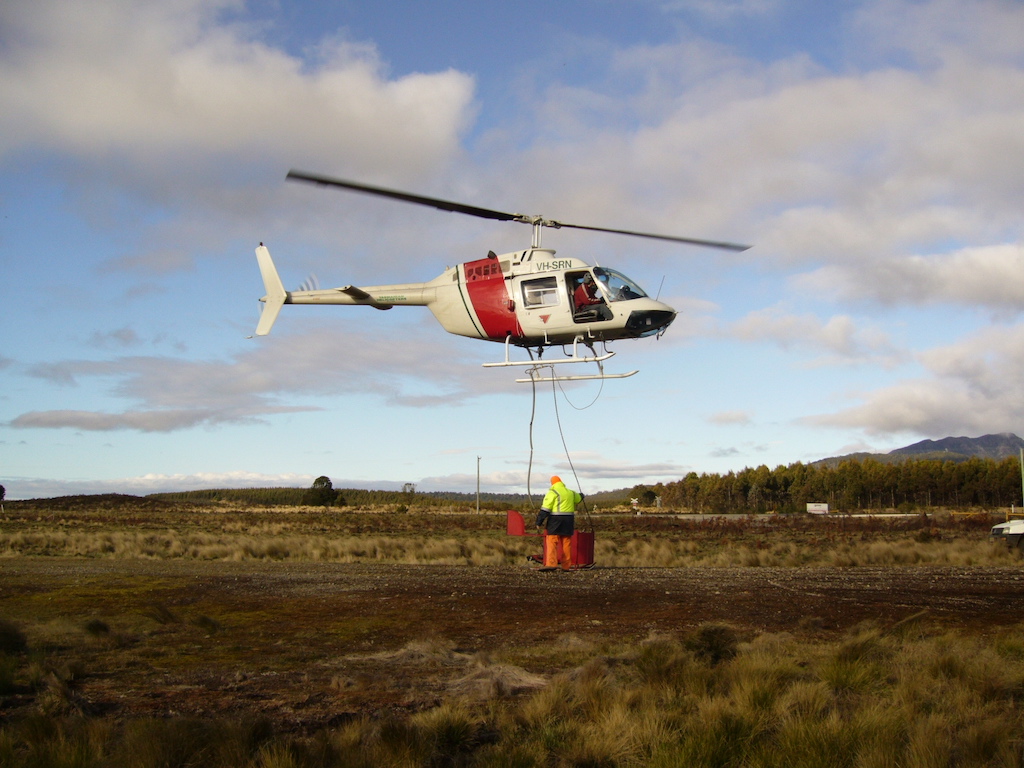
Helicopters also proved to be a very efficient platform for lighting windrows and prescribed burns. Suitably equipped, they dramatically reduced the manpower and time taken to burn a given area.
The eponymously named “Red Dragon” helitorch, made from a tank to hold gelled petrol, is still the core item of equipment for burning operations. This oversized drip torch is slung beneath a helicopter. A pump attached to the tank sends a stream of gelled fuel past an igniter and globs of burning fuel fall to the ground. The pilot has control of the pump and igniter and regulates the application rate. The tank is stabilised in flight by an integrated tail assembly. Sometimes a forester (a “bombardier”) will be in the helicopter to provide positional advice to the pilot.
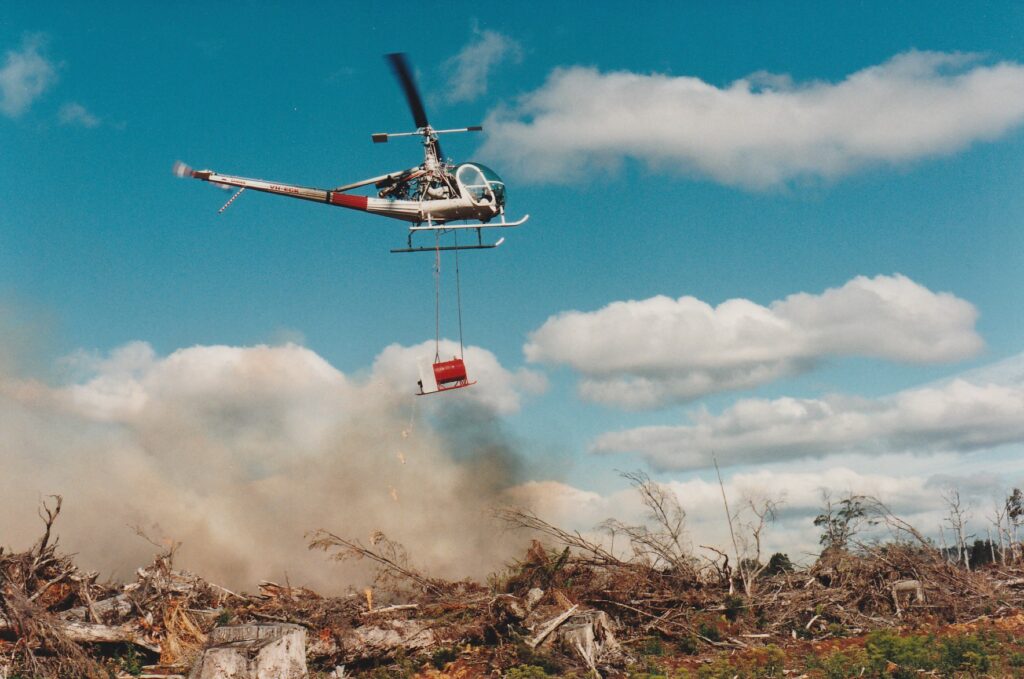
Darryl built his own helitorches using components sourced from New Zealand and, as the lift capacity of newer helicopters increased, the capacity of the tanks increased from 180 litres to 600 litres. While the helicopter is away lighting, the ground crew prepares another batch of fuel at a staging area, often in a second helitorch, by adding a gelling agent to the petrol in the tank. The gelling reaction is temperature dependent and takes ten or so minutes to complete. The freshly filled Red Dragon is then, with the helicopter hovering close to the ground, quickly swapped for the empty one, adding to the efficiency of the operation.
As an aside, Les Baker, in his conversation with Ian Ravenwood, touched on the use of helicopters for applying fertilisers. Apart from the limited use of tractor mounted Vicon pendulum fertiliser spreaders on ex-pasture sites, fertiliser was and is still mainly applied by hand when a plantation is established. However, as the result of trial work in the 1990s by the company’s soil scientist Greg Holz, the benefit of later-age fertilising was recognised. This was most accurately carried by helicopters with a slung spreading bucket.
Darryl has always been an innovator and has not been afraid to make investments in new and better technologies. Ultra-low volume nozzles followed hollow cone nozzles and high-water volumes per hectare, then moved back to bigger volumes and more uniform droplet sizes. The spray gear itself continually improved. Nozzle and fertiliser bucket technology improvements were verified by pattern testing and measuring the coefficient of variation of test cards laid out in the operational area.
The Flying Flagman system was initially used to mark sprayed areas, with aircraft dropped flagging tape, enabling pilots to line up the next swath. However, aerial operations are very hard and intense work for pilots, and Darryl recognised that differential GPS technology would improve accuracy whilst making it easier for pilots. So he installed the first aircraft mounted system in Australia. It was a primitive but valuable system. And very expensive. It is now standard technology for aerial application services worldwide.
This likeable kiwi found plenty of friendly faces at Ridgley, and many of those friendships endure to the present day. For example, Trevor Docking lived on a small rural block at Ridgley, and for the first year or so, Darryl often left the Hiller at his place overnight and drove home in the ute to reduce the time spent ferrying it between his Latrobe base and Surrey Hills. Darryl would ring Trevor between four and five in the morning to do a weather check before deciding whether driving up was worthwhile. He recalls calling Trevor one morning for a weather check at what he believed to be 5:00 am. Trevor called him back 30 minutes later and asked if he realised it was 1:30 am. That’s how keen he was. Darryl said that he had not seen Trevor for quite a while until recently, and it was as if they had last met the day before.

Most interesting behind the scenes activities revealed. More to come I hope in future chapters.
A great read, so nice to read about so many familiar names and their history. You were always a wealth of knowledge Ian, hope there is more to come.
Most interesting!
Thanks
Very, very interesting and well told.
A great read and I confess I had an image of a wry smile on Les and Duncan’s faces as Ross chundered in the plane.
Top read!
I have the propeller from the Beach Barron aircraft that crashed behind Nolan’s Hill in the early 80s. I was lucky enough to pick it up after it was retrieved from a scrap metal dealer in Burnie.
Thanks Ian for getting the evolution of aerial spraying ops for AFH/North/Gunns…now Forico – into a simple and entertaining read.
The fixed wing operators led by Ray Bender and John Jones did all they could to keep mainland operators out of Tasmania. I was at ANM when all that changed.
It heralded better service and much more competitive rates. Darryl Taylor was a leader in adopting new technology. I recall taking the Board of the APVMA to a demonstration of his low drift technology.
I don’t think they had ever encountered such a professional operator. Darryl helped us to revolutionise silvicultural operations.
I don’t think Ag operations are at the same standard even now.
Great article Ian.
Very interesting and informative blog.
Thanks Ian for providing a great read. In my time as a surveyor at AFH & NFP I had the opportunity to use Darryl’s services to land me in places that were hard to reach or took a long time to walk to.
One such place was the top of Valentines Peak. I remember having to offload the theodolite, legs and other equipment using a rope as Darryl couldn’t land due to strong crosswind. I managed to get to within 1 metre of the top so I could then jump down. Not sure it would pass OHS requirements today!
And yes Darryl did come back and pick me up safely.
Hi Mike.
A lot of names in these articles I haven’t heard for years, including yours.
Great write up Ian. I have fond recollections of my time at Ridgley (2005-2011) with you, Trevor Docking, Wray Watts, George Harris and Josie McCarthy.
I personally logged up to 30 flying hours a year, burning and spraying from Nietta to Woolnorth and everywhere in-between, with Darryl’s pilots, including Bruce Colwell, Nick Talbot and others. Also enjoyed working with the Tas Heli ground crew of Peter Lapthorn and Rosco Popowski, and our own Cyril Hodgetts – some unforgettable characters.